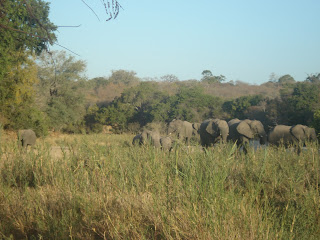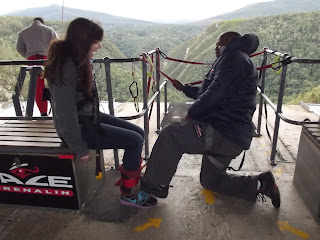In Jo'burg, we stayed at Gemini Backpacker, which did not quite live up
to its reputation. It advertised the availability of meals and a gym, neither
of which was true. Additionally, there was an ENORMOUS spider in our dorm the
first night we stayed, which prevented me from sleeping at all even though
someone killed it. I was quite convinced that its family had to be close by.
The next morning I went on a tour of Soweto, which stands
for the southwestern township of Jo’burg, established during the apartheid
years as a settlement for Africans. I found that Soweto has an even larger
wealth disparity than the Cape Town townships, boasting a beautiful wealthy
neighborhood that was much nicer than my neighborhood in the suburbs of DC. We
also learned that crime within Soweto is very low, since criminals in the
townships prefer to commit crimes outside of their own community, generally
going into town to rob homes. As the crime rate is so low, these incredibly
beautiful, fancy homes often had no fence at all, unlike every single house in
Jo’burg, which is usually covered in barbed wire.
The township contains the
former house of Nelson and Winnie Mandela (before, during, and for a short time
after Mandela’s prison term), which has since been converted to a museum, and
the current Jo’burg home of Desmond Tutu, who was in Cape Town when we drove by
his house.
I had just read the night before the section of Long Walk to Freedom
pertaining to 8115 Vilakazi Street, the matchbox house that once belonged to the
Mandelas. When he arrived after his dramatic release from prison, there were so
many people outside the house that they could not get in, and for weeks
afterward they were kept awake by hundreds of well wishers singing outside the
house.
We also spent some time learning about the 1974 student uprising in Soweto,
which left more than 600 students, teachers, doctors, and others dead after
students began a seemingly peaceful protest against the use of a Afrikaans as
the official language in schools. As we learned about martyrs such as young
Hector Pieterson and others, it occurred to me that these children were so much
younger than I am now, and the student leaders of the movement were my age.
It’s incredible to think that they changed the course of their country’s
history at such an age. We then moved one of the informal settlements
containing shacks, where a resident showed us around and told us a bit about
their living conditions.
The shacks seems similar to those in Cape Town, but
this particular neighborhood seemed more carefully planned out, with each shack
having a yard and a fence (very rare in Cape Town townships from what I have
seen). This is not only more comfortable for residents but also reduces the
risk of death and destruction due to fire, which are enormous in the townships.
Just last week nearly 100 people were killed, wounded, or left homeless by
fires in Cape Town townships alone. After our walk through the shacks, we
stopped at a local restaurant shack, which reminded me of a small and slightly
fancier version of Mzoli’s in Gugulethu, and we had a delicious feast of ginger
beer, pap, sauces, many vegetables and salads for only R30. Talk about low cost
of living!
I loved Soweto and didn’t want to leave. I told this to the tour
guide, who said that I should move to Soweto later in life with my family—we
would be the first white family to live in Soweto. I was surprised by this, but
apparently there are fewer than 10 white residents, and they are all single
members of primarily coloured or black families.
The next morning we were picked up at 5:30 AM by Livingstone
Trails for our 4-day Kruger safari adventure. We stopped at the Hoedspruit Cheetah
Conservation Centre, where we learned about their rescue and conservation
activities for not only cheetahs but also many other animals that are
threatened by humans (e.g. farmers who often shoot them because they prey on sheep). Cheetahs are not
particularly successful hunters, despite their speed. And when they do finally
catch their prey, it’s stolen 14% of the time by a stronger predator, such as a
lion. Poor little cheetahs…
We then stopped at Thornybush Game Reserve which bordered
our safari lodge for a private sunset game drive. The reserve was different
from the previous reserve I visited, since the wild nature of the animals is
preserved—there are no enclosures and the animals are still, for the most part,
are afraid of humans. We saw many animals, including lions just a few feet
away!
We observed a herd of elephants, who were less than happy with the
presence of one of the vehicles.
We also saw one of the male rhinos, whose horn
was surgically fused with poison to discourage poachers—the poison (used in
other private reserves as well) has been linked to a few deaths of horn powder
consumers in China. So far on this reserve, no poachers have been successful
due to their particularly good anti-poaching patrols. All reserves have these
patrols due to the incredibly high number of poaching incidents over the last
few years. Both white and black rhinos are on track to be extinct by 2015 at
this rate of poaching.
We learned the day after visiting the reserve that the week
before we arrived, two of the patrols were not following procedure and had both
fallen asleep during their shift (one is supposed to be awake at all times, but
this doesn’t always happen because so few people are willing to do such a dangerous
job, and therefore the few patrols have to work 48-hour or longer shifts). One
of them had earbuds in and was listening to music (again, major breach of
protocol—you must be aware of your surroundings at all times). The patrol who
was listening to music was actually yanked out of his sleeping bag by a lion
and eaten while his terrified coworker radioed for help, which came too late.
The bartender who told us the story made us feel only slightly better by
letting us know that the lion had been put down, and that it is rare for lions
on a reserve to have a “maneater” personality. However, we already knew that
there were many predators on the grounds of our campsite, and that there were
holes in the fence that would have allowed the Thornybush lions to sneak onto
our campsite, had they wanted to. However, in the 25 years of the lodge’s
operation, they have never had a lion on the grounds. Leopards, on the other
hand, are another story. One leopard was
spotted a few hundred feet from our tents on our first night by a motion censor
camera—spooky!
There were also many warthogs, who like to hang around the tents
to look for leftover food, and other animals like impala, waterbuck, hyenas,
zebras and more.
We could hear them all night long! I’m the first to admit that I was quite terrified and barely slept the first couple of days. We all went to the outdoor bathroom in packs for fear of a leopard attack. I always carried a hard object with me just in case I needed to scare an animal away. Aside from the constant fear of being eaten, camping was incredibly fun. I had never slept outside in a tent before, and it was incredibly freeing to sleep under the stars.
We could hear them all night long! I’m the first to admit that I was quite terrified and barely slept the first couple of days. We all went to the outdoor bathroom in packs for fear of a leopard attack. I always carried a hard object with me just in case I needed to scare an animal away. Aside from the constant fear of being eaten, camping was incredibly fun. I had never slept outside in a tent before, and it was incredibly freeing to sleep under the stars.
We left early in the morning to get to Kruger National Park
as the gates opened. The morning started out slowly, with only a few sightings
of common animals like giraffes and elephants (ellies, as the South Africans
call them).
But soon we had great luck! We spotted a honey badger (very rare, you can see it running away from us in the photo), dwarf mongooses, and then an entire pride of lions hunting around our car!
We also saw large numbers of zebra, rhinos, and giraffes. Although zebra are commonly found in large numbers, rhinos and giraffes are usually found alone or in very small groups. We happened to run into large numbers of males who were vying for dominance.
On our way home the next day, we stopped briefly at Blyde River Canyon-- the third largest canyon in the world! The views were stunning.
And so ended our 10-day trip around South Africa. It was a whirlwind tour of a large portion of the country, but I wouldn't have had it any other way. I hope I can come back someday and spend more time in different areas of the country.































































